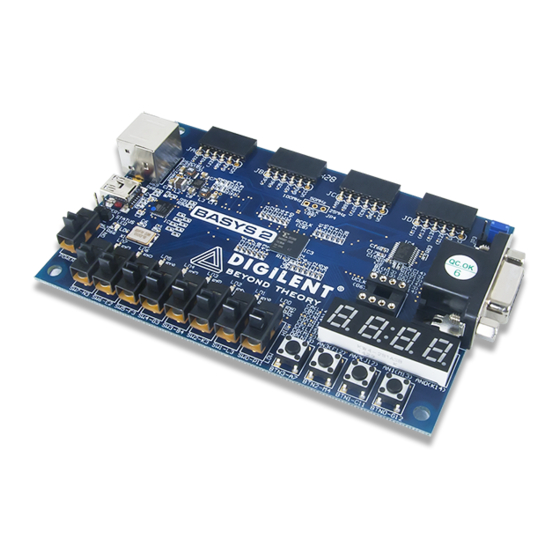Digilent Basys 2 Referans Kılavuzu - Sayfa 7
Bilgisayar Donanımı Digilent Basys 2 için çevrimiçi göz atın veya pdf Referans Kılavuzu indirin. Digilent Basys 2 12 sayfaları. Fpga board

Basys2™ FPGA Board Reference Manual
The keyboard sends data to the host in 11-bit words that contain a '0' start bit, followed by 8-bits of scan code (LSB
first), followed by an odd parity bit and terminated with a '1' stop bit. The keyboard generates 11 clock transitions
(at around 20 - 30KHz) when the data is sent, and data is valid on the falling edge of the clock.
ESC
F1
F2
76
05
06
` ~
1 !
2 @
3 #
0E
16
1E
26
TAB
Q
W
0D
15
1D
Caps Lock
A
S
58
1C
1B
Shift
Z
12
1Z
22
Ctrl
Alt
14
11
5.2
Mouse
The mouse outputs a clock and data signal when it is moved; otherwise, these signals remain at logic '1'. Each time
the mouse is moved, three 11-bit words are sent from the mouse to the host device. Each of the 11-bit words
contains a '0' start bit, followed by 8 bits of data (LSB first), followed by an odd parity bit, and terminated with a '1'
stop bit. Thus, each data transmission contains 33 bits, where bits 0, 11, and 22 are '0' start bits, and bits 11, 21,
and 33 are '1' stop bits. The three 8-bit data fields contain movement data as shown in the figure above. Data is
valid at the falling edge of the clock, and the clock period is 20 to 30KHz.
The mouse assumes a relative coordinate system wherein moving the mouse to the right generates a positive
number in the X field, and moving to the left generates a negative number. Likewise, moving the mouse up
generates a positive number in the Y field, and moving down represents a negative number (the XS and YS bits in
the status byte are the sign bits – a '1' indicates a negative number). The magnitude of the X and Y numbers
represent the rate of mouse movement – the larger the number, the faster the mouse is moving (the XV and YV
bits in the status byte are movement overflow indicators – a '1' means overflow has occurred). If the mouse moves
continuously, the 33-bit transmissions are repeated every 50ms or so. The L and R fields in the status byte indicate
Left and Right button presses (a '1' indicates the button is being pressed).
Mouse status byte
1
0
L
R
0
1 XS YS XY YY P
Start bit
Idle state
Copyright Digilent, Inc. All rights reserved.
Other product and company names mentioned may be trademarks of their respective owners.
F3
F4
F5
04
0C
03
4 $
5 %
6 ^
7 &
25
2E
36
3D
E
R
T
Y
24
2D
2C
35
D
F
G
H
23
2B
34
33
X
C
V
B
21
2A
32
Space
29
Figure 11. Keyboard scan codes.
X direction byte
1
0
X0 X1 X2 X3 X4 X5 X6 X7 P
Stop bit
Start bit
Figure 12. Mouse data format.
F6
F7
F8
F9
0B
83
0A
01
8 *
9 (
0 )
- _
3E
46
45
4E
U
I
O
P
3C
43
44
4D
J
K
L
; :
3B
42
4B
4C
N
M
, <
> .
31
3A
41
49
Alt
E0 11
1
0
Y0 Y1 Y2 Y3 Y4 Y5 Y6 Y7 P
Stop bit
Start bit
F10
F11
F12
09
78
07
E0 75
= +
BackSpace
E0 74
55
66
[ {
] }
\ |
54
5B
5D
E0 6B
' "
Enter
52
5A
E0 72
/ ?
Shift
4A
59
Ctrl
E0 14
Y direction byte
Stop bit
Idle state
Page 7 of 12
1
